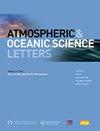Enhanced nitrous acid (HONO) formation via NO2 uptake and its potential contribution to heavy haze formation during wintertime
IF 3.2
4区 地球科学
Q3 METEOROLOGY & ATMOSPHERIC SCIENCES
引用次数: 0
Abstract
A full understanding of the sources of atmospheric nitrous acid (HONO) in the polluted urban atmosphere remains a challenge. In this study, ambient HONO and relevant species were measured during January 2019 at an urban site in Beijing, China, and a budget analysis of HONO was conducted using a box model combined with field observations. Large nighttime “missing sources” of HONO were identified on heavily polluted days based on traditional sources, which had a significant correlation with the relative humidity, ammonia (NH3), and aerosol surface area, and the promotional effect of NH3 for nitrogen dioxide (NO2) uptake on the wet aerosol surface was discussed. Then, an updated parameterization scheme for quantifying the enhanced heterogeneous reactions of NO2 on aerosol surfaces is proposed, and the missing nighttime sources of HONO could be substantially compensated after the new scheme was incorporated. Further evaluation on the contributions of HONO to hydroxyl radicals was conducted, and the authors found that the photolysis of HONO played a dominant role in the primary OH production on the polluted days (78%–90%). The study reveals great potential of an NH3-enhanced uptake coefficient of NO2 on the aerosol surface in the nocturnal HONO budget, and highlights the significance of HONO in the strong atmospheric oxidation capability during episodes with a heavily polluted atmosphere.
摘要
本文研究了重污染过程中气态亚硝酸 (HONO) 的关键来源并基于化学箱模型对其源汇过程进行了闭合分析. 结果显示, 现有的HONO 源汇机制并不能解释观测期间出现的高HONO事件, 尤其是重污染过程夜间存在大量的HONO "未知源". 本文提出了一套新的HONO 源汇参数化方案, 可以较好的模拟观测期间HONO日间和夜间来源, 并进一步评估了HONO 对羟基自由基 (OH) 的贡献, 发现 HONO 光解主导了重污染天OH生成 (78%–90%). 研究结果揭示了华北城市富氨大气环境促进 NO2在气溶胶表面的摄取和非均相反应进而主导了夜间HONO生成, 凸显了HONO化学对于重污染过程维持大气氧化能力的重要作用.
通过吸收二氧化氮增强亚硝酸(HONO)的形成及其对冬季重度灰霾形成的潜在作用
全面了解受污染城市大气中的大气亚硝酸(HONO)来源仍然是一项挑战。在本研究中,我们于 2019 年 1 月在中国北京的一个城市站点测量了环境中的 HONO 和相关物种,并使用箱式模型结合实地观测结果对 HONO 进行了预算分析。根据传统来源确定了重污染日夜间大量的HONO "缺失源",与相对湿度、氨(NH3)和气溶胶表面积有显著相关性,并讨论了NH3对湿气溶胶表面二氧化氮(NO2)吸收的促进作用。然后,提出了一种用于量化二氧化氮在气溶胶表面增强的异质反应的最新参数化方案,在纳入新方案后,缺失的夜间 HONO 来源可以得到大幅补偿。作者进一步评估了 HONO 对羟基自由基的贡献,发现 HONO 的光解在污染日的一次羟基自由基生成中占主导地位(78%-90%)。该研究揭示了气溶胶表面的 NH3 增强吸收系数在夜间 HONO 预算中的巨大潜力,并强调了 HONO 在大气重污染过程中对大气强氧化能力的重要作用。摘要本文研究了重污染过程中气态亚硝酸 (hono) 的关键来源并基于化学箱模型对其源汇过程进行了闭合分析。结果显示, 现有的 hono 源汇机制并不能解释观测期间出现的高 hono 事件, 尤其是重污染过程夜间存在大量的 hono "未知源"。本文提出了一套新的 hono 源汇参数化方案, 可以较好的模拟观测期间 hono 日间和夜间来源, 并进一步评估了 hono 对羟基自由基 (oh) 的贡献, 发现 hono 光解主导了重污染天oh 生成 (78%-90%)。研究结果揭示了华北城市富氨大气环境促进 no2 在气溶胶表面的摄取和非均相反应进而主导了夜间 hono 生成, 凸显了 hono 化学对于重污染过程维持大气氧化能力的重要作用。
本文章由计算机程序翻译,如有差异,请以英文原文为准。
求助全文
约1分钟内获得全文
求助全文
来源期刊

Atmospheric and Oceanic Science Letters
METEOROLOGY & ATMOSPHERIC SCIENCES-
CiteScore
4.20
自引率
8.70%
发文量
925
审稿时长
12 weeks
 求助内容:
求助内容: 应助结果提醒方式:
应助结果提醒方式:


